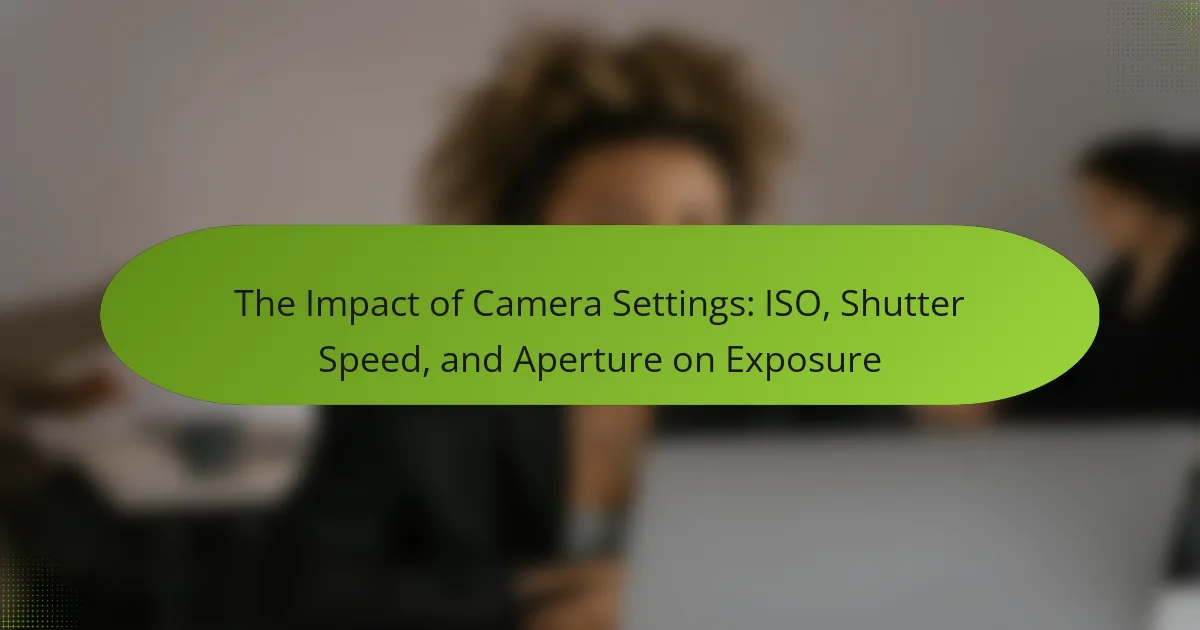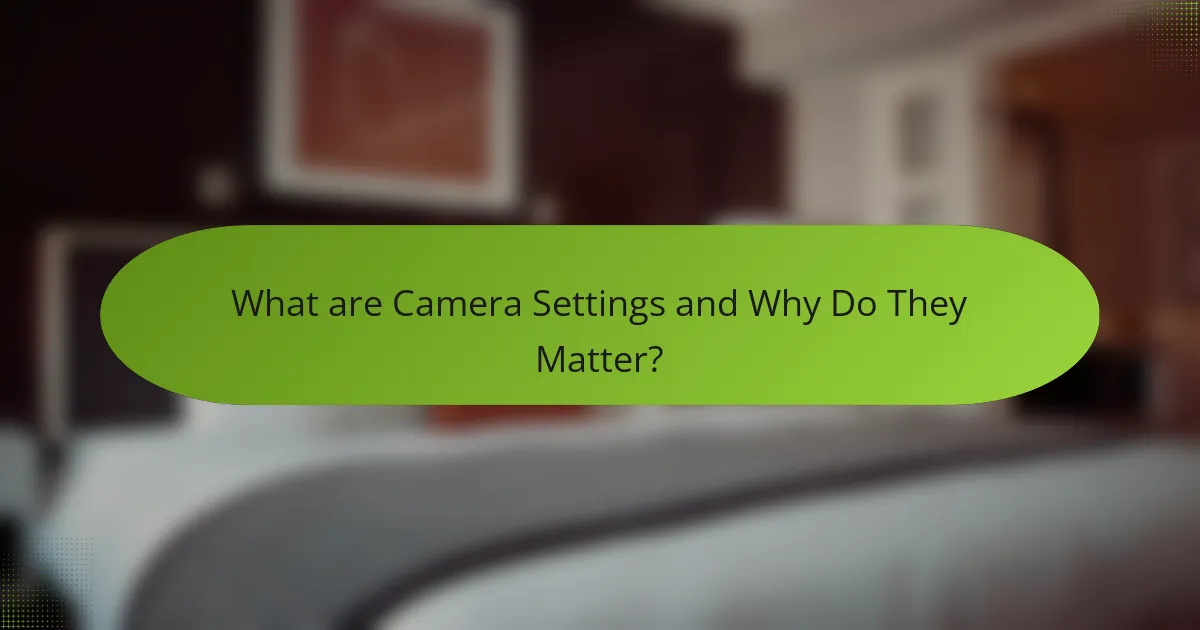
What are Camera Settings and Why Do They Matter?
Camera settings are the adjustable parameters that control how a camera captures images. They include ISO, shutter speed, and aperture. Each setting influences the exposure, clarity, and overall quality of a photograph. ISO determines the camera’s sensitivity to light. A higher ISO allows for better performance in low light but may introduce noise. Shutter speed controls the duration the camera’s sensor is exposed to light. Faster speeds freeze motion, while slower speeds can create motion blur. Aperture affects the depth of field and the amount of light entering the camera. A wider aperture results in a shallower depth of field, isolating subjects from the background. Properly adjusting these settings is crucial for achieving the desired exposure and artistic effect in photography. Understanding camera settings enables photographers to make informed decisions, leading to improved image quality and creativity.
How do ISO, Shutter Speed, and Aperture influence Exposure?
ISO, shutter speed, and aperture are the three key elements that influence exposure in photography. ISO refers to the camera’s sensitivity to light. A higher ISO allows for better performance in low-light conditions but may introduce noise. Shutter speed controls the duration the camera’s sensor is exposed to light. A faster shutter speed freezes motion, while a slower speed can create motion blur. Aperture, measured in f-stops, determines the size of the lens opening. A wider aperture lets in more light and creates a shallow depth of field, while a smaller aperture allows less light and increases depth of field. Together, these settings must be balanced to achieve the desired exposure. Adjusting one setting often requires compensating with the others to maintain proper exposure levels.
What is Exposure in Photography?
Exposure in photography refers to the amount of light that reaches the camera sensor. It determines how bright or dark an image appears. Proper exposure is achieved through a combination of aperture, shutter speed, and ISO settings. Aperture controls the size of the lens opening, affecting depth of field. Shutter speed dictates how long the sensor is exposed to light. ISO measures the sensor’s sensitivity to light. Balancing these three elements is crucial for achieving the desired exposure. Inadequate exposure can result in images that are either too bright (overexposed) or too dark (underexposed).
Why is Understanding Exposure Crucial for Photographers?
Understanding exposure is crucial for photographers because it directly affects the quality of their images. Exposure determines how light or dark an image appears. Proper exposure ensures that details are visible in both highlights and shadows. Photographers manipulate exposure through three main settings: ISO, shutter speed, and aperture. Each setting impacts the amount of light that reaches the camera sensor. For instance, a higher ISO increases sensitivity to light, while a slower shutter speed allows more light in over time. Conversely, a wider aperture lets in more light but also affects depth of field. Mastering exposure techniques allows photographers to create desired effects and convey emotions. Studies show that well-exposed images are more visually appealing and engaging to viewers. Understanding exposure ultimately enhances a photographer’s creative control and technical proficiency.
What are the Key Components of Camera Settings?
The key components of camera settings are ISO, shutter speed, and aperture. ISO measures the camera sensor’s sensitivity to light. A higher ISO allows for better performance in low light but increases noise. Shutter speed controls the duration the camera’s sensor is exposed to light. Faster shutter speeds freeze motion, while slower speeds create motion blur. Aperture refers to the size of the lens opening, affecting depth of field and light intake. A wider aperture allows more light and creates a shallow depth of field, while a narrower aperture reduces light and increases depth of field. These components work together to determine exposure in photography.
What is ISO and How Does it Affect Exposure?
ISO is a measure of a camera’s sensitivity to light. A higher ISO value increases sensitivity, allowing for better performance in low-light conditions. Conversely, a lower ISO value reduces sensitivity, which is ideal for bright environments. Increasing ISO can lead to more noise or grain in images, affecting overall quality. For example, an ISO setting of 100 is suitable for sunny days, while 1600 or higher is often used in dim lighting. This relationship between ISO and exposure is critical for photographers to achieve desired results in varying lighting conditions.
What Role Does Shutter Speed Play in Capturing Images?
Shutter speed determines the duration that a camera’s sensor is exposed to light. It plays a crucial role in capturing images with the right exposure. Faster shutter speeds freeze motion, preventing blur in fast-moving subjects. For example, a shutter speed of 1/1000 seconds can capture a bird in flight clearly. Conversely, slower shutter speeds allow more light, which can create motion blur. A shutter speed of 1/30 seconds can give a sense of movement in a flowing waterfall. The choice of shutter speed affects not just exposure but also the artistic expression of the image. Properly adjusting shutter speed is essential for achieving desired photographic effects.
How Does Aperture Impact Depth of Field and Exposure?
Aperture significantly impacts both depth of field and exposure in photography. A wider aperture (smaller f-number) allows more light to enter the camera. This results in a brighter image, enhancing exposure. Conversely, a narrower aperture (larger f-number) reduces light intake, leading to a darker image.
Depth of field refers to the range of distance that appears sharp in an image. A wider aperture creates a shallower depth of field, isolating the subject from the background. This effect is often used in portrait photography to emphasize the subject. A narrower aperture increases depth of field, keeping more of the scene in focus. This is beneficial for landscape photography.
The relationship between aperture, depth of field, and exposure is critical for achieving desired photographic effects. Understanding this relationship allows photographers to manipulate settings for creative outcomes.
How Do These Camera Settings Interact with Each Other?
ISO, shutter speed, and aperture interact to control exposure in photography. ISO determines the sensor’s sensitivity to light. A higher ISO allows for better performance in low light but may introduce noise. Shutter speed controls the duration the sensor is exposed to light. Faster shutter speeds freeze motion, while slower speeds capture motion blur. Aperture, measured in f-stops, affects the amount of light entering the lens. A wider aperture (lower f-stop) allows more light and creates a shallow depth of field.
These settings work together to achieve the desired exposure. For instance, increasing ISO can compensate for a faster shutter speed or a smaller aperture. Conversely, a lower ISO may require a wider aperture or slower shutter speed to maintain exposure. Understanding their interaction allows photographers to creatively manipulate light and achieve specific effects.
What is the Exposure Triangle and How Does it Work?
The Exposure Triangle is a fundamental concept in photography that describes the relationship between ISO, shutter speed, and aperture. These three elements work together to determine the exposure of an image. ISO measures the camera sensor’s sensitivity to light. A higher ISO allows for better performance in low light conditions but can introduce noise. Shutter speed controls the duration the camera’s sensor is exposed to light. Faster shutter speeds freeze motion, while slower speeds can create motion blur. Aperture refers to the size of the lens opening, influencing the amount of light entering the camera. A wider aperture allows more light and creates a shallow depth of field, while a smaller aperture reduces light and increases depth of field. Together, these elements allow photographers to achieve the desired exposure and artistic effect in their images.
How Can Adjusting One Setting Affect the Others?
Adjusting one camera setting can significantly impact the others due to the exposure triangle. The exposure triangle consists of ISO, shutter speed, and aperture, which work together to control the exposure of an image. For instance, increasing the ISO makes the sensor more sensitive to light. This allows for a faster shutter speed, which reduces motion blur. However, a higher ISO can introduce noise, affecting image quality. Conversely, if you open the aperture to let in more light, you may need to decrease the shutter speed to avoid overexposure. Each adjustment influences the overall exposure and depth of field in a photograph. Understanding this interdependence is crucial for achieving the desired photographic effect.
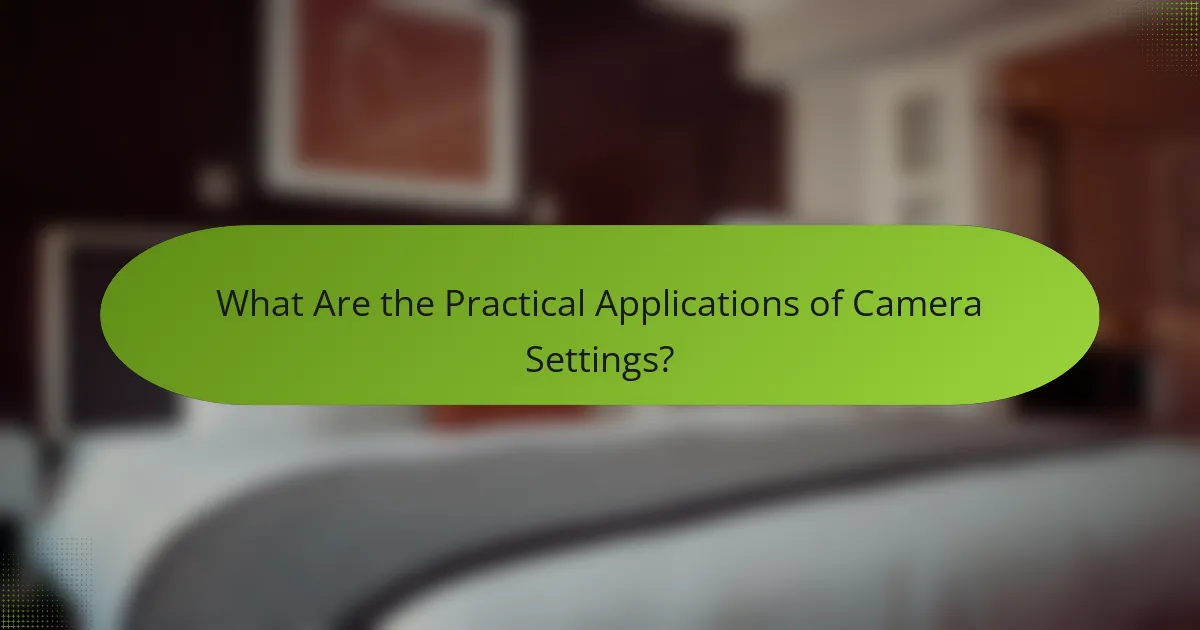
What Are the Practical Applications of Camera Settings?
Camera settings are essential for achieving desired exposure, depth of field, and motion effects in photography. Practical applications include adjusting ISO to manage noise in low-light conditions. Shutter speed controls motion blur, allowing for sharp images of fast-moving subjects. Aperture affects depth of field, enabling selective focus on subjects while blurring backgrounds. These settings work together to create specific artistic effects. For example, a fast shutter speed can freeze action, while a wide aperture can create a bokeh effect. Understanding these applications enhances photographic creativity and technical proficiency.
How Can Photographers Optimize Camera Settings for Different Scenarios?
Photographers can optimize camera settings for different scenarios by adjusting ISO, shutter speed, and aperture. For low-light conditions, increase ISO to capture more light without a flash. A higher ISO, such as 1600 or 3200, allows for faster shutter speeds, reducing motion blur. In bright conditions, lower the ISO to 100 or 200 to avoid overexposure.
Adjusting shutter speed is crucial for motion capture. A fast shutter speed, like 1/1000 of a second, freezes action in sports photography. Conversely, a slower shutter speed, such as 1/30 of a second, creates motion blur for artistic effects.
Aperture settings influence depth of field. A wide aperture (e.g., f/2.8) creates a shallow depth of field, isolating subjects in portraits. A narrow aperture (e.g., f/16) increases depth of field, suitable for landscapes.
Balancing these settings according to lighting and subject movement ensures optimal exposure. Photographers often use the exposure triangle to evaluate the relationship between ISO, shutter speed, and aperture for desired outcomes.
What Camera Settings Should Be Used for Low Light Conditions?
For low light conditions, set a high ISO, a slow shutter speed, and a wide aperture. A high ISO increases the camera’s sensitivity to light. Values between 800 and 3200 are commonly used in low light. A slow shutter speed allows more light to hit the sensor. Speeds of 1/30 seconds or slower can be effective. A wide aperture, such as f/1.8 or f/2.8, lets in more light. These settings help achieve proper exposure in dim environments. Adjusting these settings balances the exposure triangle effectively.
How to Adjust Settings for Fast-Moving Subjects?
To adjust settings for fast-moving subjects, use a fast shutter speed. A shutter speed of 1/500 seconds or faster is often recommended. This helps freeze motion and reduce blur. Increase the ISO setting to maintain exposure with faster shutter speeds. A higher ISO, such as 800 or 1600, compensates for reduced light. Aperture settings should be wide, like f/2.8 or f/4, to allow more light. This combination enhances the ability to capture sharp images of moving subjects. This method is effective in sports photography and wildlife photography, where motion is rapid.
What Common Mistakes Should Photographers Avoid?
Photographers should avoid several common mistakes to improve their craft. One mistake is neglecting to understand exposure settings. Properly adjusting ISO, shutter speed, and aperture is crucial for achieving the desired exposure. Another mistake is failing to compose the shot effectively. Good composition enhances the visual impact of an image. Additionally, photographers often overlook the importance of lighting. Natural light can significantly affect the quality of photos. Many also forget to check their focus before shooting. Blurry images can be disappointing and unprofessional. Lastly, not backing up images can lead to loss of valuable work. Regularly saving files prevents potential data loss.
How Can Overexposure and Underexposure Be Prevented?
Overexposure and underexposure can be prevented by adjusting camera settings appropriately. Use the correct ISO setting for the lighting conditions. A lower ISO reduces sensitivity to light, preventing overexposure in bright environments. Conversely, a higher ISO can be used in low-light situations to avoid underexposure.
Adjust the shutter speed to control the duration of light exposure. A faster shutter speed minimizes light intake, helping to prevent overexposure. A slower shutter speed allows more light, which can prevent underexposure in darker settings.
Set the aperture to manage the amount of light entering the camera. A smaller aperture (higher f-stop number) reduces light, helping to prevent overexposure. A larger aperture (lower f-stop number) allows more light, which is beneficial in low-light conditions to avoid underexposure.
Regularly reviewing the camera’s histogram can provide visual feedback on exposure levels. This tool helps photographers identify if adjustments are necessary to achieve proper exposure.
What Tips Can Help in Achieving the Perfect Exposure?
To achieve perfect exposure, adjust ISO, shutter speed, and aperture correctly. Start by setting your ISO to the lowest possible value for minimal noise. Next, select an appropriate shutter speed based on the movement in your scene. For stationary subjects, slower shutter speeds can be used. For moving subjects, faster shutter speeds are necessary to freeze motion. Lastly, choose the right aperture to control depth of field. A wider aperture (lower f-number) allows more light and creates a blurred background, while a narrower aperture (higher f-number) increases depth of field. Use a light meter or histogram to evaluate exposure levels. This ensures your image is neither overexposed nor underexposed.
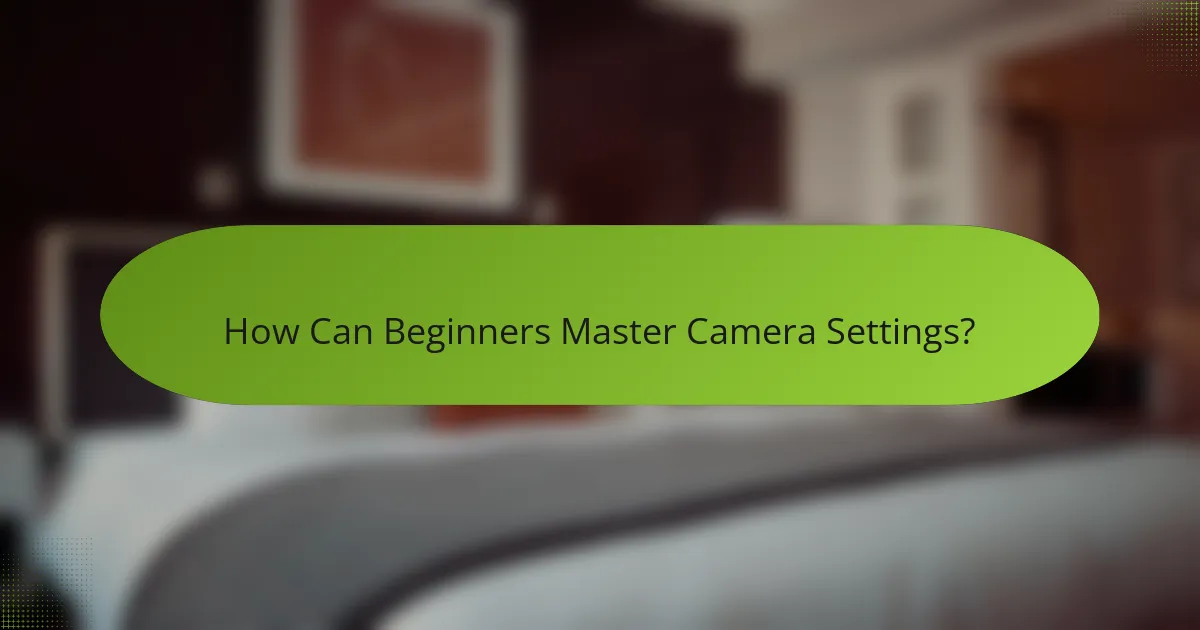
How Can Beginners Master Camera Settings?
Beginners can master camera settings by understanding three core components: ISO, shutter speed, and aperture. ISO controls the camera’s sensitivity to light. A higher ISO allows for better low-light performance but increases noise. Shutter speed determines how long the camera’s sensor is exposed to light. Faster shutter speeds freeze motion, while slower speeds capture motion blur. Aperture affects the depth of field and the amount of light entering the lens. A wider aperture creates a shallow depth of field, while a narrower aperture increases depth of field. Practicing with these settings in various lighting conditions helps beginners gain proficiency. Additionally, using the camera’s manual mode facilitates hands-on learning, allowing users to experiment and see the immediate effects of their adjustments.
What Resources Are Available for Learning Camera Settings?
Online tutorials and courses are available for learning camera settings. Websites like Udemy and Coursera offer structured courses. YouTube hosts numerous channels focused on photography techniques. Books such as “Understanding Exposure” by Bryan Peterson provide in-depth knowledge. Photography blogs often feature articles explaining camera settings. Community forums like Reddit’s r/photography allow for peer advice and shared experiences. Local photography workshops can offer hands-on learning opportunities. Many camera manufacturers provide user manuals that explain settings in detail.
How Can Online Tutorials and Courses Enhance Understanding?
Online tutorials and courses enhance understanding by providing structured learning experiences. They offer visual aids and demonstrations that clarify complex concepts. Interactive elements, such as quizzes and discussions, reinforce knowledge retention. Access to expert instructors allows for immediate feedback and clarification of doubts. According to a study by the Online Learning Consortium, students in online courses perform better than those in traditional settings. This is attributed to the flexibility and personalized pace of online learning. Additionally, online platforms often include diverse resources, catering to various learning styles. This multifaceted approach fosters deeper comprehension of topics like camera settings and exposure.
What Books or Guides Are Recommended for New Photographers?
“Understanding Exposure” by Bryan Peterson is highly recommended for new photographers. This book explains the relationship between ISO, shutter speed, and aperture. It provides practical examples and clear explanations. Another excellent resource is “The Digital Photography Book” by Scott Kelby. This guide offers straightforward tips and techniques for beginners. “Complete Digital Photography” by Ben Long is also beneficial. It covers fundamental concepts and camera settings in detail. These books are widely praised for their clarity and usefulness in mastering photography basics.
What Practical Tips Can Help Improve Photography Skills?
To improve photography skills, practice regularly and experiment with different camera settings. Understanding ISO, shutter speed, and aperture is crucial. ISO controls the camera’s sensitivity to light. A higher ISO allows for better performance in low light but may introduce noise. Shutter speed determines how long the camera’s sensor is exposed to light. Faster shutter speeds freeze motion, while slower speeds create motion blur. Aperture affects depth of field and light entering the camera. A wider aperture creates a shallow depth of field, isolating subjects. An essential tip is to analyze and learn from your photos. Review your work to identify strengths and weaknesses. Additionally, studying composition techniques enhances visual storytelling. Engaging with photography communities provides valuable feedback and inspiration. Lastly, investing time in post-processing can significantly enhance images.
How to Practice Adjusting Camera Settings in Real-World Scenarios?
To practice adjusting camera settings in real-world scenarios, start by selecting various environments. Choose locations with different lighting conditions, such as bright sunlight, shade, and low light. Experiment with ISO settings to see how they affect image noise and exposure. Adjust shutter speed to capture motion, observing the impact on blurriness or sharpness. Change aperture settings to manipulate depth of field and focus. Use a tripod to stabilize shots in low-light situations. Review images after each adjustment to evaluate results. This hands-on approach reinforces understanding of ISO, shutter speed, and aperture’s effects on exposure.
What Exercises Can Help Solidify Knowledge of Exposure?
Practical exercises can solidify knowledge of exposure in photography. One effective exercise is to take photos at different ISO settings while keeping shutter speed and aperture constant. This helps understand how ISO affects image brightness and noise. Another exercise involves varying the shutter speed while maintaining the same ISO and aperture. This demonstrates the impact of motion blur and exposure time on images. Additionally, experimenting with different apertures while keeping ISO and shutter speed constant can clarify depth of field and light intake. Analyzing the results of these exercises reinforces the relationship between ISO, shutter speed, and aperture in achieving proper exposure.
The main entity of the article is camera settings, specifically focusing on ISO, shutter speed, and aperture, and their impact on exposure in photography. The article outlines how these three key components interact to determine image brightness, clarity, and artistic effect. It explains the roles of each setting, including how ISO affects light sensitivity, shutter speed controls exposure duration, and aperture influences depth of field. Additionally, practical applications and tips for optimizing these settings in various scenarios are discussed, along with common mistakes to avoid and resources for further learning. Understanding these elements is essential for photographers to achieve desired exposure and enhance their creative control.
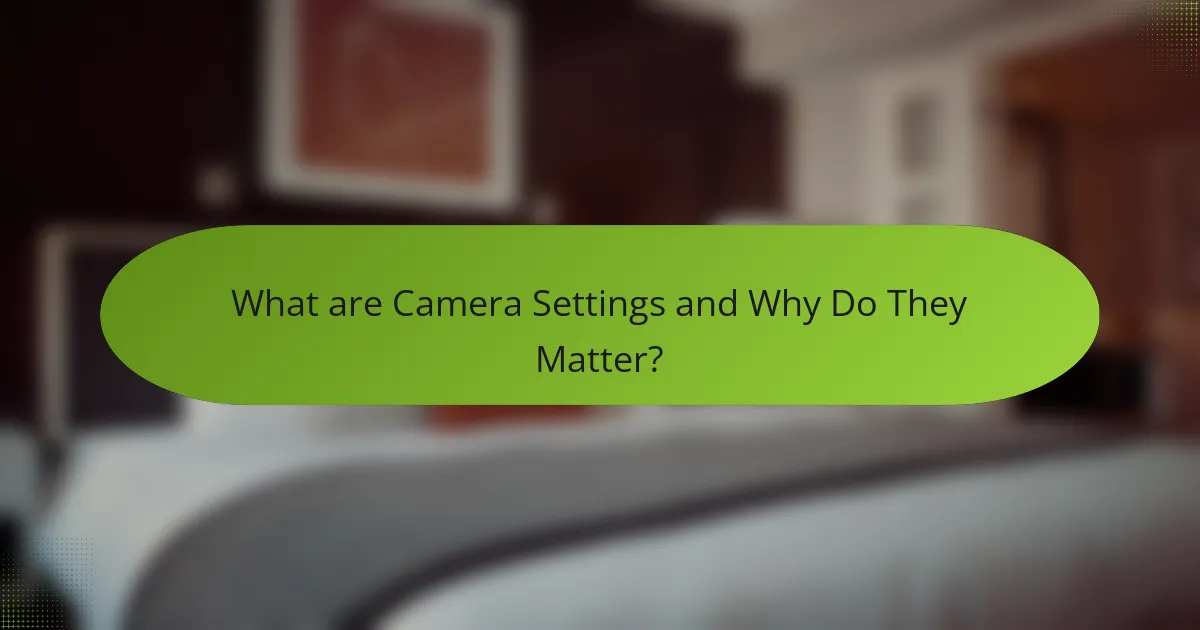
What are Camera Settings and Why Do They Matter?
Camera settings are the adjustable parameters that control how a camera captures images. They include ISO, shutter speed, and aperture. Each setting influences the exposure, clarity, and overall quality of a photograph. ISO determines the camera’s sensitivity to light. A higher ISO allows for better performance in low light but may introduce noise. Shutter speed controls the duration the camera’s sensor is exposed to light. Faster speeds freeze motion, while slower speeds can create motion blur. Aperture affects the depth of field and the amount of light entering the camera. A wider aperture results in a shallower depth of field, isolating subjects from the background. Properly adjusting these settings is crucial for achieving the desired exposure and artistic effect in photography. Understanding camera settings enables photographers to make informed decisions, leading to improved image quality and creativity.
How do ISO, Shutter Speed, and Aperture influence Exposure?
ISO, shutter speed, and aperture are the three key elements that influence exposure in photography. ISO refers to the camera’s sensitivity to light. A higher ISO allows for better performance in low-light conditions but may introduce noise. Shutter speed controls the duration the camera’s sensor is exposed to light. A faster shutter speed freezes motion, while a slower speed can create motion blur. Aperture, measured in f-stops, determines the size of the lens opening. A wider aperture lets in more light and creates a shallow depth of field, while a smaller aperture allows less light and increases depth of field. Together, these settings must be balanced to achieve the desired exposure. Adjusting one setting often requires compensating with the others to maintain proper exposure levels.
What is Exposure in Photography?
Exposure in photography refers to the amount of light that reaches the camera sensor. It determines how bright or dark an image appears. Proper exposure is achieved through a combination of aperture, shutter speed, and ISO settings. Aperture controls the size of the lens opening, affecting depth of field. Shutter speed dictates how long the sensor is exposed to light. ISO measures the sensor’s sensitivity to light. Balancing these three elements is crucial for achieving the desired exposure. Inadequate exposure can result in images that are either too bright (overexposed) or too dark (underexposed).
